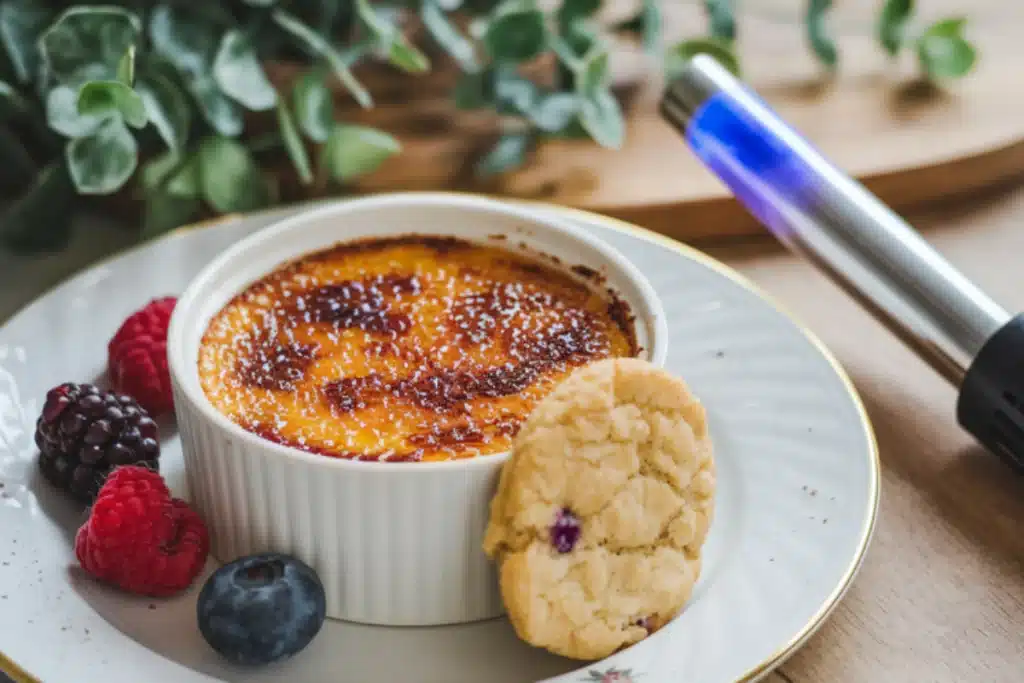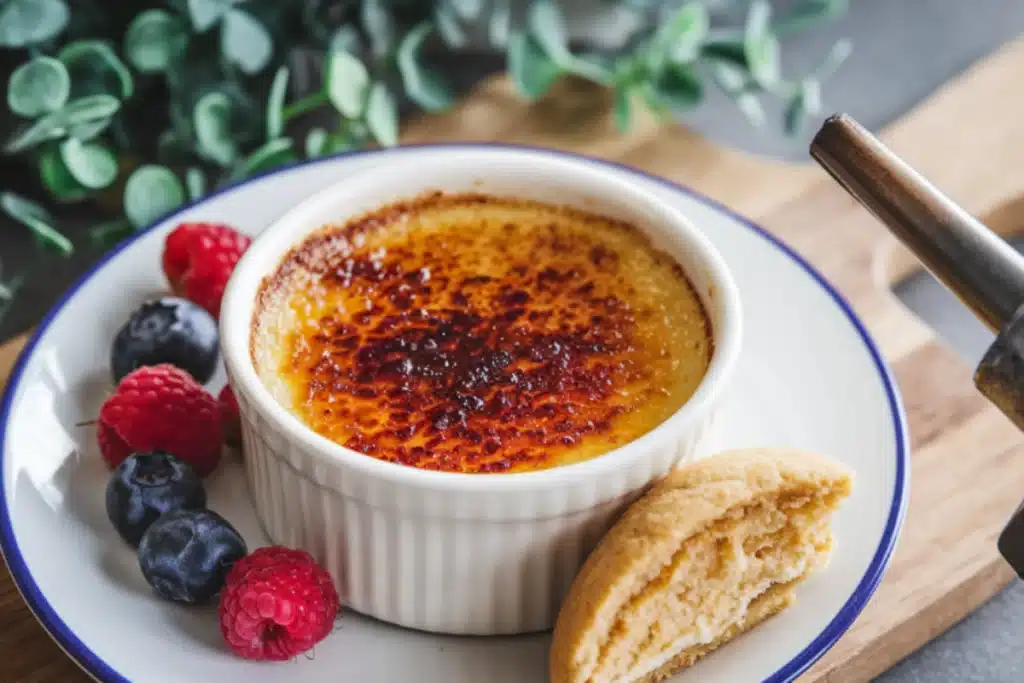Introduction
Crème Brûlée is a classic French dessert adored for its creamy custard base topped with a crackling caramelized sugar crust. Traditionally, it’s served in ramekins—those small, round dishes that have become synonymous with this indulgent treat. But do you have to use ramekins for Crème Brûlée? What happens if you don’t have them on hand? This article explores the necessity of ramekins, discusses alternatives, and delves into the techniques to achieve the perfect Crème Brûlée, no matter what dish you use.
The Role of Ramekins in Crème Brûlée
When you think of Crème Brûlée, you likely imagine the dessert being served in a small ramekin. This isn’t by accident; ramekins are designed to cook the custard evenly and present it beautifully. Their compact size allows the custard to set correctly, ensuring the top layer of sugar caramelizes without overheating the custard underneath. The typical ramekin size—4 to 6 ounces—is perfect for individual servings, making it easier to portion out your dessert.
Pro Tip: A ramekin’s thick walls help retain heat, making them ideal for slow-cooking custards like Crème Brûlée. If you want to see various ramekin options, check out this comprehensive guide to ramekins.
But what if you don’t have ramekins? Fortunately, there are alternatives.
Can You Use Other Types of Dishes for Crème Brûlée?
Absolutely! While ramekins are preferred, other dishes can work in a pinch. However, each alternative comes with its own set of challenges. Below are some common options and their pros and cons:
- Ceramic Bowls: These are a great substitute as they have similar heat retention properties as ramekins. However, the size may vary, affecting cooking time.
- Glass Dishes: They offer a clear view of the custard as it cooks, which is great for monitoring. But be cautious, as glass can lead to uneven cooking.
- Mason Jars: Trendy and functional, mason jars are oven-safe and can work well, but be careful with high heat as they can crack.
- Metal Dishes: While metal heats quickly, it can overcook the edges of your custard, leaving the center underdone.
Comparison Table: Ramekins vs. Alternatives
| Dish Type | Pros | Cons | Recommended Cooking Adjustments |
|---|---|---|---|
| Ramekins | Even cooking, perfect size | None | Follow standard recipe |
| Ceramic Bowls | Similar to ramekins, aesthetic | Size varies, longer cook time | Adjust cooking time by +5 minutes |
| Glass Dishes | Monitor cooking, stylish | Uneven heat, risk of cracking | Reduce oven temperature by 25°F |
| Mason Jars | Trendy, versatile | Prone to cracking under high heat | Use lower rack, increase water bath |
| Metal Dishes | Heats fast | Uneven cooking, overbrowns | Lower temperature, check at half-time |
Why Are Ramekins Ideal for Making Crème Brûlée?
The reason why ramekins are the go-to for Crème Brûlée lies in their design. Ramekins are typically made of ceramic, which distributes heat evenly during the baking process. This ensures that the custard cooks through without scorching or becoming grainy. Additionally, ramekins are small, allowing the custard to set correctly. The shallow depth of a ramekin helps achieve that perfect ratio of custard to caramelized sugar topping.
For a deeper dive into the science behind custard-making, check out this detailed article on mastering Crème Brûlée from Carlsbad Cravings.

Adjusting Your Recipe for Different Dishes
If you decide to use an alternative to ramekins, you’ll need to make some adjustments to your recipe:
- Cooking Time: Larger dishes will require longer cooking times. Check your custard frequently to avoid overcooking the edges while leaving the center underdone.
- Water Bath Importance: The bain-marie or water bath technique is essential, no matter what dish you use. It ensures that the custard cooks gently and evenly. If using larger or deeper dishes, ensure that the water reaches halfway up the sides of the dish.
Pro Tip: For a perfect water bath, consider using a roasting pan that can accommodate both your dishes and the water bath. This ensures even heat distribution and prevents the custard from curdling.
Perfecting the Caramelization: Torch vs. Broiler
The sugar topping on Crème Brûlée is what gives it that signature crack when you tap into it with a spoon. Traditionally, this is achieved with a kitchen torch, which quickly caramelizes the sugar without heating the custard underneath. However, if you don’t have a torch, your broiler can work too.
Torch Method
- Pros: This is the preferred method as it gives you precise control over the caramelization process. Simply sprinkle a thin layer of sugar over the set custard and move the torch in a circular motion until the sugar melts and browns.
- Cons: Requires purchasing a kitchen torch if you don’t already have one.
Broiler Method
- Pros: No extra tools needed.
- Cons: Uneven browning, risk of burning the sugar. Place your custards under the broiler on the top rack of your oven. Keep a close eye on them, as the sugar can go from perfectly caramelized to burnt in seconds. Consider rotating the dishes halfway through for even browning.
Comparing Ramekins and Other Dishes for Crème Brûlée
| Method | Pros | Cons | Best Use |
|---|---|---|---|
| Torch | Quick, even caramelization | Requires purchasing a tool | For precise, professional results |
| Broiler | No extra tools needed | Uneven browning, risk of burning | When a torch isn’t available |
Crème Brûlée FAQs: Ramekin Alternatives and More
What happens if you don’t use ramekins for Crème Brûlée?
Using different dishes can affect the cooking time and texture. Larger dishes may require longer cooking times, and the custard might not set as evenly as it would in ramekins.
Can you make Crème Brûlée in a large baking dish?
Yes, but be mindful that the custard may cook unevenly, with the edges setting before the center. Consider using a lower oven temperature and longer cooking time to mitigate this.
Is a water bath necessary for all dish types?
Absolutely. A water bath helps cook the custard gently, preventing it from curdling or becoming grainy.
What are the best ramekin alternatives?
If you don’t have traditional ramekins on hand, don’t worry! There are several alternative dishes you can use to make Crème Brûlée, such as ceramic bowls, glass dishes, or even Mason jars. Each option comes with its own set of pros and cons, so be sure to adjust your cooking times accordingly. For more insights and variations on the classic Crème Brûlée recipe, check out this detailed guide that explores different preparation methods and tools.
Can you make Crème Brûlée without a torch?
Yes, you can use your oven’s broiler. Just keep a close eye on it to prevent burning the sugar topping.
How can dish size affect Crème Brûlée?
Smaller dishes will cook faster, while larger or deeper dishes will take longer to set. Always check for a slight jiggle in the center to know when it’s done.
Conclusion
Ramekins are the traditional and most recommended choice for Crème Brûlée, but they aren’t absolutely necessary. By understanding how different dish materials and sizes affect the cooking process, you can adapt and still create this classic dessert successfully.
Dish Material
Your choice of dish material significantly influences how the custard sets and the sugar caramelizes. Ramekins, made from ceramic or porcelain, excel at retaining heat and ensuring consistent cooking. However, using alternatives like ceramic bowls, glass dishes, or Mason jars requires adjusting your technique. For example, lower the oven temperature by 25°F when using glass dishes to prevent uneven cooking. Similarly, be cautious with Mason jars to avoid cracking under high heat.
Dish Size
The size of your dish impacts both the texture and cooking time of the Crème Brûlée. Smaller dishes like ramekins allow for quicker, more even cooking. Larger or deeper dishes, on the other hand, may need extended cooking times and could lead to uneven custard setting. When using larger dishes, reduce the oven temperature and bake for a longer time to achieve uniform texture.
Detailed Explanation of the Water Bath (Bain-Marie) for Crème Brûlée
A water bath, also known as a bain-marie, is a crucial technique in making Crème Brûlée, regardless of whether you are using traditional ramekins or alternative dishes. The water bath helps create the gentle, even heat necessary to achieve the smooth, creamy texture that Crème Brûlée is known for. Without it, the custard is at risk of overheating, which can lead to undesirable textures like curdling or graininess.
How the Water Bath Works:
The water bath involves placing your baking dishes (ramekins or otherwise) in a larger pan, then filling the pan with hot water until it reaches halfway up the sides of the dishes. This surrounding water moderates the heat from the oven, ensuring that the custard cooks slowly and evenly. The water prevents the outer edges of the custard from cooking faster than the center, which is particularly important for delicate desserts like Crème Brûlée.
Why It’s Essential:
The water bath is especially important when using alternative dishes that may not conduct heat as evenly as ramekins. For instance, metal or glass dishes can cause the custard to cook unevenly, leading to parts that are overcooked and others that are underdone. The water bath acts as a buffer, maintaining a stable cooking temperature that results in a uniformly set custard with a silky texture.
Avoiding Common Issues:
Without a proper water bath, the custard in your Crème Brûlée may overcook, particularly along the edges, while the center remains underdone. This uneven cooking can result in a custard that is either too firm or too runny, with a texture that is far from the smooth, luxurious consistency that defines a perfect Crème Brûlée. Additionally, overheating the custard can cause it to curdle, resulting in a grainy texture that is difficult to salvage.
Pro Tips for Success:
- Use Hot Water: Always start with hot water when filling the larger pan for the water bath. This helps the custard begin cooking evenly right from the start.
- Avoid Water Splashes: Be careful not to let any water splash into the custard, as this can disrupt the texture.
- Monitor the Water Level: Ensure that the water level remains consistent during baking; if too much evaporates, the custard may cook too quickly.
Caramelization
To achieve the signature caramelized sugar crust, use a kitchen torch or broiler. A torch allows for precise caramelization, but a broiler can also provide that perfect crackle if you monitor it closely. Be mindful that different dishes, particularly those made from glass or metal, may respond differently to direct heat, so adjust as needed to avoid burning.
Final Thoughts on Ramekins and Crème Brûlée Variations
Next time you find yourself without ramekins, embrace creativity. Success in making Crème Brûlée lies in controlling the key elements of temperature, cooking time, and caramelization—regardless of the dish you use. Follow these guidelines to achieve a restaurant-quality dessert that will impress anyone, regardless of the dish it’s served in.
For those interested in exploring a unique twist on the classic Crème Brûlée, check out this Crab
